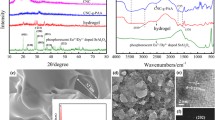Abstract
A colorimetric material was prepared and evaluated for simple and rapid detection of copper ion and other toxic metal ions. In this study, a colorimetric 1-(2-pyridylazo)-2-naphthol entrapped polyacrylamide (PAN-PAA) hydrogels was successfully prepared through polymerization and characterized by FT-IR. PAN-PAA hydrogels were evaluated for naked eye detection of Cu(II) ions in water. A yellow colour solution change into pink visual colour was observed within 20 min when hydrogel treated with Cu(II) ions at 300 μg L–1 (ppb). The colour ntensity increased with increasing concentration of Cu(II) ions. The reaction time of colour change observed less time when concentration of metal ion is increasing such as1 mg L–1 (15 min), 2 mg L–1 (10 min) and 3 mg L–1 (5 min). UV-visible spectra of PAN-PAA hydrogel shows absorbance at wavelength 560 nm with copper ions without interference of other metal ions viz. Cd(II), Co(II), Ni(II), Fe(II), Hg(II) and Pb(II). The hydrogels can be regenerated with 1 N HCl after reaction of Cu(II) ions. In conclusion, PAN-PAA hydrogel can be used as a potential colorimetric material for detection of Cu(II) ions in water. Colorimetric methods have their own advantages such as simplicity, high sensitivity and a short response time. In particular, these methods can be monitored by the naked eye and potential application in on-site detection owing to their simplicity and potability.



Similar content being viewed by others
REFERENCES
Bioinorganic Chemistry, Trautwein, A.X., Ed., Weinheim: Wiley, 1997.
Brewer, G.J., Copper toxicity in the general population, Clin. Neurophysiol., 2010, vol. 121, no. 4, pp. 459–460.
Que, E.L., Domaille, D.W., and Chang, C.J., Metals in neurobiology: Probing their chemistry and biology with molecular imaging, Chem. Rev., 2008, vol. 108, no. 5, pp. 1517–1549.
WHO Guidelines for Drinking-Water Quality, Geneva: World Health Org., 2004.
Judith, R.T., Human whole-body copper metabolism, Am. J. Clin. Nutr., 1998, vol. 67, pp. 960–967.
Agarwal, S.K., Tiwari, S.C., and Dash, S.C., Spectrum of poisoning requiring hemodialysis in a tertiary care hospital in India, Int. J. Artif. Organs, 1993, vol. 16, no. 1, pp. 20–22.
Bannon, D.I. and Chisolm, J.J., Anodic stripping voltammetry compared with graphite furnace atomic absorption spectrophotometry for blood lead analysis, Clin. Chem., 2001, vol. 47, no. 9, pp. 1703–1704.
Liu, H.W., Jiang, S.J., and Liu, S.H., Determination of cadmium, mercury and lead in seawater by electrothermal vaporization isotope dilution inductively coupled plasma mass spectrometry, Spectrochim. Acta, Part B, 1999, vol. 54, no. 9, pp. 1367–1375.
Eksperiandova, L.P., Blank, A.B., and Makarovskaya, Y.N., Analysis of wastewater by X-ray fluorescence spectrometry, X-Ray Spectrom., 2002, vol. 31, no. 3, pp. 259–263.
Trigo-López, M., Muñoz, A., Ibeas, S., Serna, F., García, F.C., and García, J.M., Colorimetric detection and determination of Fe(III), Co(II), Cu(II) and Sn(II) in aqueous media by acrylic polymers with pendant terpyridine motifs, Sens. Actuators, B, 2016, vol. 226, pp. 118–126.
Na, Y.J., Choi, Y.W., You, G.R., and Kim, C., A novel selective colorimetric chemosensor for cobalt ions in a near perfect aqueous solution, Sens. Actuators, B, 2016, vol. 223, pp. 234–240.
Zhou, Y., Wang, S., Zhang, K., and Jiang, X., Visual detection of copper(II) by azide- and alkyne-functionalized gold nanoparticles using click chemistry, Angew. Chem., Int. Ed., 2008, vol. 47, no. 39, pp. 7454–7456.
Kimura, K. and Murakami, Y., New modified colorimetric method of determination of copper in biological materials with sodium diethyldithio-carbamate, Microchim. Acta, 1951, vol. 36, no. 2, pp. 958–966.
Makino, T. and Itoh, J.I., A highly sensitive colorimetric determination of serum copper using α,β,γ,δ‑tetrakis(4-N-trimethylaminophenyl)porphine, Clin. Chim. Acta, 1981, vol. 111, no. 1, pp. 1–8.
Callejón Mochón, M. and Gomez Ariza, J.L., Girard-P derivative of 2-pyridinecarboxaldehyde as analytical reagent. Spectrophotometric determination of copper, Microchem. J., 1981, vol. 26, no. 4, pp. 463–471.
Singh, I., Poonam, M., and Kadyan, P.S., Spectrophotometric determination of iron and copper in milk, foodstuffs and body tissues with 1-(2-quinolylazo)-2,4,5-trihydroxybenzene, Talanta, 1985, vol. 32, no. 5, pp. 387–395.
Bosch Ojeda, C., Garcia de Torres, A., Sanchez Rojas, F., and Cano Pavón, J.M., Determination of copper with 1,5-bis(di-2-pyridylmethylene)thiocarbonohydrazide: Determination of copper in alloys, Microchem. J., 1987, vol. 35, no. 2, pp. 164–176.
Kumar, B., Singh, H.B., Katyal, M., and Sharma, R.L., Spectrophotometric and derivative spectrophotometric determination of copper (II) with dithizone in aqueous phase, Microchim. Acta, 1991, vol. 105, nos. 1–3, pp. 79–87.
Li, S., Li, S., and Chen, A., Spectrophotometric determination of trace copper with a Cu-diethyldithiocarbamate-β-cyclodextrincoloursystem, Talanta, 1993, vol. 40, no. 7, pp. 1085–1090.
Sharma, L.S., Kumar, J.R., Reddy, K.J., and Reddy, A.V., Development of an extractive spectrophotometric method for the determination of copper (II) in leafy vegetable and pharmaceutical samples using pyridoxal-4-phenyl-3-thiosemicarbazone (PPT), J. Agric. Food Chem., 2005, vol. 53, no. 14, pp. 5492–5498.
Shishehbore, M.R., Nasirizadeh, N., Shabani, A.M.H., and Tabatabaee, M., Spectrophotometric determination of trace copper after pre-concentration with 1,5-diphenylcarbazone on microcrystalline naphthalene, Can. J. Anal. Sci. Spectrosc., 2005, vol. 50, pp. 130–134.
Clesceri, L.S., Greenberg, A.E., and Eaton, A.D., Standard Methods for the Examination of Water and Wastewater, Denver, CO: Am. Water Works Assoc., 2012, 22nd ed.
ACKNOWLEDGMENTS
Authors are thankful to Dr. S.R. Vadera, OS and Director, Defence Laboratory, Jodhpur, for guidance and encouragement. Authors would like to thank Deepesh Patidar, for his technical suggestions for preparation of manuscript. We wish to thank Ravindra Kumar, Sc-G, for his suggestions and help throughout the writing of manuscript. The authors thank Dr. M.S. Roy, Sc-F and Narotam Prasad for extending UV visible spectra analysis facility.
Author information
Authors and Affiliations
Corresponding author
About this article
Cite this article
Rajesh Kumar, Verma, S. & Kachwaha, M. 1-(2-Pyridylazo)-2-Naphthol Entrapped Polyacrylamide Hydrogels: Detection of Copper Ions in Water. J. Water Chem. Technol. 43, 330–335 (2021). https://doi.org/10.3103/S1063455X2104007X
Received:
Revised:
Accepted:
Published:
Issue Date:
DOI: https://doi.org/10.3103/S1063455X2104007X




